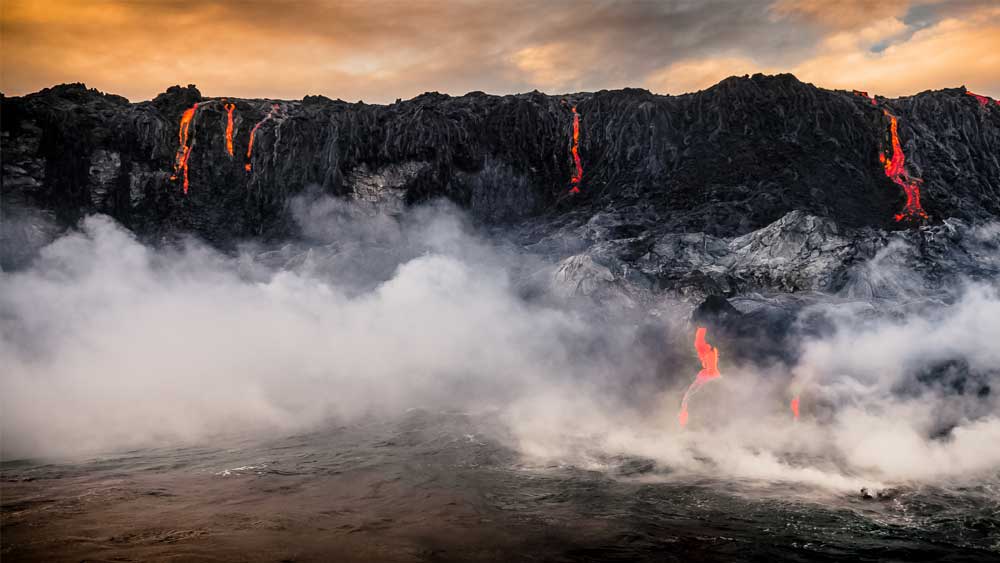This really should be no surprise, because today’s volcanoes still produce vast amounts of CO2 and water. However, these scientists were able to find evidence of vast quantities of ancient CO2 still trapped in the rocks themselves.
Manfredo Capriolo from the University of Padova, Italy, and a consortium of scientists from institutions across Europe and Morocco collected over 200 samples of igneous rock (formerly molten) from North America, Africa, and Western Europe. These rocks were all part of the similarly-aged Central Atlantic Magmatic Province (CAMP) that intruded and produced extensive lavas across eastern North America, South America, western Africa, and even part of Southeast Europe.
This CAMP volcanic activity is associated with the initial break-up of the supercontinent of Pangaea and the beginning of the modern Atlantic Ocean. Secular scientists claim the rocks are about 201 million years old, falling right at the end of the Triassic in the rock record.1
Furthermore, uniformitarian scientists assert that the end of the Triassic coincided with a massive extinction event. They claim that the end of the Triassic is one of the “big five” extinctions in geologic history. Others extinctions include the Permian-Triassic and the Cretaceous-Paleogene, which are both thought to have been even bigger extinctions.
Capriolo and his co-authors found carbon dioxide and water vapor-bearing bubbles in about 20 of the 200 samples.1 Few other volatiles (vapor-rich) compounds were identified. They discovered that the CAMP igneous rocks were all rich in CO2.1 The authors wrote:
The CO2-bearing bubbles identified in CAMP MIs [melt inclusions in the minerals] can be interpreted as batches of ascending volatiles [bubbles] entrapped in crystalline mush shortly prior to its mobilization and prior to its eruption.
They added, “For instance, CO2-rich Hawaiian basalts have been shown to rapidly rise from over 5 km [3.1 miles] depth and to cause high fountaining eruptions.”1
Capriolo and his colleagues totaled up the volume of CO2 released and concluded,
Our estimates suggest that the amount of CO2 that each CAMP magmatic pulse injected into the end-Triassic atmosphere is comparable to the amount of anthropogenic emissions projected for the 21st century.1
They went on to speculate that this massive release of CO2 during the formation of the CAMP could be a main cause of the end-Triassic extinction. Hannah Osborne reported,
David Bond, from the U.K.'s University of Hull, whose research focuses on environmental changes during mass extinctions and who was not involved in the latest study, commented on the findings.2
There is little doubt that some LIPs [Large Igneous Provinces] cause mass extinctions. However, there are examples of huge LIPs that do not seem to have given a 'deadly kiss' to life on Earth. This paper by Capriolo and colleagues helps explain why some LIPs are deadly, while others are not. They look inside the anatomy of a killer, through a case study of the enormous CAMP.2
But are these real extinctions? Is CO2 the “killer” it is being made out to be? And why don’t all large igneous provinces cause extinctions?There is little doubt that some LIPs [Large Igneous Provinces] cause mass extinctions. However, there are examples of huge LIPs that do not seem to have given a 'deadly kiss' to life on Earth. This paper by Capriolo and colleagues helps explain why some LIPs are deadly, while others are not. They look inside the anatomy of a killer, through a case study of the enormous CAMP.2
In a young-earth Flood model, there are no extinctions in the rock record, only last occurrences.3 All fossils suddenly appear at some level, continue for a while unchanged, and disappear suddenly at a higher level (the claimed extinction).
Creation geologists believe much of the rock record was deposited rapidly in the year-long Genesis Flood. The end-Triassic is just a sudden change in fossil types as the floodwaters inundated higher and new levels of the pre-Flood world.4
A pre-Flood world that had different ecological zones that were simultaneously flooded globally explains what we observe in the fossil record.4 It is likely that very few land animals went extinct until after the Flood.
Uniformitarian scientists struggle to make sense of the fossil record and the causes for what they believe are extinctions. The end-Triassic “extinction” is no different. And CO2 is produced by most volcanoes. It is only the uniformitarian worldview that keeps them searching for a cause.
The answer is in plain sight. They just need to open their Bibles to the account of the Flood in the book of Genesis. Then the rocks, fossils, and volcanic activity all make sense. Massive releases of CO2 are nothing to be feared.
References
1. Capriolo, M., el at. 2020. Deep CO2 in the end-Triassic Central Atlantic Magmatic Province. Nature Communications. 11:1670.
2. Osborne, H. Projected CO2 emissions similar to those released by volcanoes during mass extinction even 200 million years ago. Newsweek. Posted on newsweek.com April 7, 2020, accessed April 14, 2020.
3. Clarey, T. 2020. Carved in Stone. Dallas, TX: Institute for Creation Research, 90-113.
4. Ibid, 400-417.
*Dr. Clarey is Research Associate at the Institute for Creation Research and earned his doctorate in geology from Western Michigan University.














